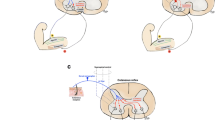Abstract
Background: In several instances, the diagnosis of brain death has been questioned due to the presence of movements. This case report and review of the literature illustrates the spectrum of movements that have been encountered in brain death.
Methods: A case report and review of the literature on movements seen in brain death was conducted.
Results: Movements in brain death are common and have a wide range of phenomenology. Several movements wax and wane over time, making movements in brain death difficult to classify. In addition, varying terminology has been used (e.g., Lazarus sign, spinal man, spinal reflexes, spinal automatisms). Although evidence points to a spinal origin for such movements, the pathophysiology in many cases remains speculative. Characteristics of movements in brain death have been identified that can help differentiate them from brainstem or voluntary origin.
Conclusions: Based on our review, we suggest referring to stimulus-provoked movements as reflexes and spontaneous movements as automatisms. We propose using the terms brain death-associated reflexes and brain death-associated automatisms as two main categories for movements that occur in brain death. These terms do not imply a specific pathophysiology, but consistent clinically oriented nomenclature may be useful when reporting such phenomena.
Similar content being viewed by others
References
Saposnik G, Maruino J, Bueri JA. Movements in brain death. Eur J Neurol 2001;8:209–213.
Wijdicks EFM. The diagnosis of brain death. N Engl J Med 2001;344:1215–1221.
Plum F, Posner J. The diagnosis of stupor and coma, 3rd ed. Philadelphia: F.A. Davis Company, 1982.
Jorgensen EO. Spinal man after brain death. Acta Neurochir (Wien) 1973;28:259–273.
Spittler JF, Wortmann D, von During M, Gehlen, W. Phenomenological diversity of spinal reflexes in brain death. Eur J Neurol 2000;7:315–321.
Ivan L. Spinal reflexes in cerebral death. Neurology 1973;23:650–652.
Dösemeci L, Cengiz M, Yilmaz M, Ramazanoglu A. Frequency of spinal reflex movements in brain-dead patients. Transplant Proc 2004;36:17–19.
Saposnik G, Maurinoj, Saizar R, Bueri JA. Undulating toe movements in brain death. Eur J Neurol 2004;11:723–727.
Conci F, Procaccio F, Arosio M, Boselli L. Viscero-somatic and viscero-visceral reflexes in brain death. J Neurol Neurosurg Psychiatry 1986;49:695–698.
de Freitas GR, Lima MASD, Andre C. Complex spinal reflexes during transcranial Doppler ultrasound examination for the confirmation of brain death. Acta Neurol Scand 2003;108:170–173.
Urasaki E, Tokimura T, Kumai J, Wada S, Yokota A. Preserved spinal dorsal horn potentials in a brain-dead patient with Lazarus’ sign. J Neurosurg 1992;76:710–713.
Turmel A, Roux A, Bojanowski MW. Spinal man after declaration of brain death. Neurosurgery 1991;28:298–301.
Jastremski M, Powner D, Snyder J, Smith J, Grenvik A. Sponteneous decerebrate movement after declaration of brain death. Neurosurgery 1991;3:479–480.
Heytens L, Verlooy J, Gheuens J, Bossaert L. Lazarus sign and extensor posturing in a brain-dead patient. J Neurosurg 1989;71:449–451.
Ropper A. Unusual spontaneous movements in brain-dead patients. Neurology 1984;34:1089–1092.
Hanna J, Frank J. Automatic stepping in the pontomedullary stage of central herniation. Neurology 1995;45:985–986.
American Academy of Neurology. Practice parameters: determining brain death in adults. www.aan.com (accessed April 2004).
Rodrigues W, Vyas H. Movements in brain death. Eur J Neurol 2002;9:687–702.
Fujimoto K, Yamauchi Y, Yoshida M. Spinal myoclonus in association with brain death. Rinsho Shinkeigaku 1989;11:1417–1419.
Aranibar RJ. Spinal man after declaration of brain death. Neurosurgery 1991;28:933.
Friedman A. Sympathetic response and brain death. Arch Neurol 1984;41:15.
Christie J, O’Lenic T, Cane R. Head turning in brain death. J Clini Anesth 1996;8:141–143.
Marti-Fabregas J, Lopez-Navidad A, Caballero F, Otermin P. Decerebrate-like posturing with mechanical ventilation in brain death. Neurology 2000;54:224–227.
McNair NL, Meador KJ. The undulating toe flexion sign in brain death. Mov Disord 1992;7:345–347.
Author information
Authors and Affiliations
Corresponding author
Rights and permissions
About this article
Cite this article
Jain, S., DeGeorgia, M. Brain death-associated reflexes and automatisms. Neurocrit Care 3, 122–126 (2005). https://doi.org/10.1385/NCC:3:2:122
Issue Date:
DOI: https://doi.org/10.1385/NCC:3:2:122




